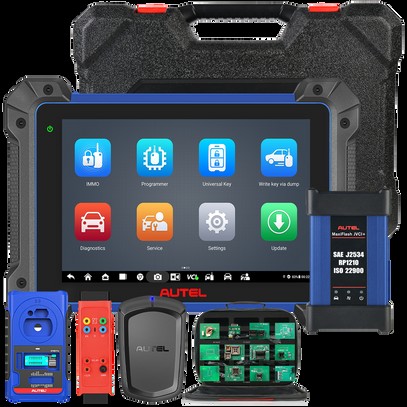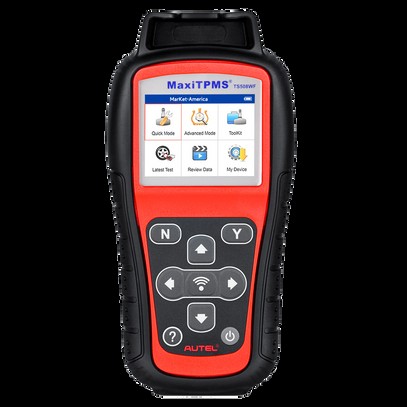A Diagnostic Car Scanner Tool is an essential tool for anyone who wants to understand and maintain their vehicle, and CAR-TOOL.EDU.VN offers a comprehensive guide to these devices. It helps identify and troubleshoot issues, from simple maintenance needs to complex engine problems. This article will cover what you need to know, including its benefits, how it works, and how to choose the right one. Explore in-depth information, compare products, and find reliable suppliers with CAR-TOOL.EDU.VN.
Contents
- 1. What Is a Diagnostic Car Scanner Tool?
- 1.1 How Does It Work?
- 1.2 Key Functions of a Car Diagnostic Scanner Tool
- 2. Who Needs a Diagnostic Car Scanner Tool?
- 2.1 Car Owners
- 2.2 Professional Mechanics
- 2.3 Auto Repair Shops and Garages
- 3. Benefits of Using a Diagnostic Car Scanner Tool
- 3.1 Early Problem Detection
- 3.2 Cost Savings
- 3.3 Time Efficiency
- 3.4 Enhanced Vehicle Performance
- 4. Different Types of Diagnostic Car Scanner Tools
- 4.1 Basic OBD-II Scanners
- 4.2 Mid-Range Scanners
- 4.3 Professional-Grade Scanners
- 4.4 Smartphone-Based Scanners
- 5. Top Diagnostic Car Scanner Tool Brands
- 5.1 Autel
- 5.2 Launch
- 5.3 Snap-on
- 5.4 Bosch
- 5.5 Innova
- 6. How to Choose the Right Diagnostic Car Scanner Tool
- 6.1 Vehicle Compatibility
- 6.2 Features and Functionality
- 6.3 Ease of Use
- 6.4 Budget
- 6.5 Reviews and Ratings
- 7. How to Use a Diagnostic Car Scanner Tool
- 7.1 Preparation
- 7.2 Connecting the Scanner
- 7.3 Diagnosing Problems
- 7.4 Clearing Codes
- 8. Diagnostic Car Scanner Tool: Addressing Customer Challenges
- 8.1 Finding Reliable Automotive Parts
- 8.2 Comparing Prices and Features
- 8.3 Ensuring Durability and Effectiveness
- 8.4 Seeking Expert Advice
- 9. Expert Insights and Advice
- 10. Frequently Asked Questions (FAQs)
- 10.1 What is the OBD-II port?
- 10.2 Can a diagnostic car scanner tool fix my car?
- 10.3 Do I need to be a mechanic to use a diagnostic car scanner tool?
- 10.4 Can a diagnostic car scanner tool damage my car?
- 10.5 How often should I scan my car for problems?
- 10.6 What is bi-directional control?
- 10.7 What is module programming?
- 10.8 What is I/M readiness testing?
- 10.9 Where can I buy a diagnostic car scanner tool?
- 10.10 How can CAR-TOOL.EDU.VN help me choose the right diagnostic car scanner tool?
- Conclusion
1. What Is a Diagnostic Car Scanner Tool?
A diagnostic car scanner tool is an electronic device used to interface with a vehicle’s onboard computer system, commonly known as the Engine Control Unit (ECU) or Engine Management System (EMS). According to a study by the National Institute for Automotive Service Excellence (ASE), modern vehicles have dozens of sensors and electronic control modules (ECMs) that monitor and control various systems, from the engine and transmission to the anti-lock braking system (ABS) and airbags. The scanner reads diagnostic trouble codes (DTCs) stored in the ECU, providing insights into potential issues.
1.1 How Does It Work?
The diagnostic car scanner tool connects to the vehicle’s On-Board Diagnostics II (OBD-II) port, typically located under the dashboard. This port provides access to the car’s computer system. Once connected, the scanner communicates with the ECU to retrieve data and error codes. This data can then be used to diagnose problems, reset warning lights, and monitor vehicle performance.
1.2 Key Functions of a Car Diagnostic Scanner Tool
According to research published in the SAE International Journal of Engines, diagnostic car scanner tools perform a range of functions that are crucial for modern vehicle maintenance and repair:
- Reading Diagnostic Trouble Codes (DTCs): Identifies the error codes that the vehicle’s computer has stored, offering a starting point for diagnosing issues.
- Clearing DTCs and Resetting Warning Lights: After repairs, clears the error codes and turns off the check engine light or other warning indicators.
- Live Data Streaming: Provides real-time data from various sensors, allowing technicians to monitor engine performance, sensor readings, and other critical parameters.
- Freeze Frame Data: Captures a snapshot of the vehicle’s data when a DTC is set, aiding in diagnosing intermittent problems.
- O2 Sensor Testing: Tests the functionality of the oxygen sensors, which are crucial for fuel efficiency and emissions control.
- I/M Readiness Testing: Checks if the vehicle is ready for emissions testing, ensuring compliance with environmental regulations.
- Vehicle Information Retrieval: Displays the vehicle identification number (VIN), calibration identification, and other important vehicle information.
2. Who Needs a Diagnostic Car Scanner Tool?
A diagnostic car scanner tool isn’t just for professional mechanics; it’s a valuable asset for car owners and enthusiasts alike. Here’s who can benefit from using one:
2.1 Car Owners
- DIY Maintenance: For car owners who prefer to perform their own maintenance, a scanner tool can help diagnose minor issues before they become major problems.
- Pre-Purchase Inspections: Before buying a used car, a scanner can reveal hidden issues that may not be apparent during a test drive.
- Cost Savings: By diagnosing and fixing problems early, car owners can save money on expensive repairs at a mechanic shop.
2.2 Professional Mechanics
- Efficient Diagnostics: Diagnostic car scanner tools enable mechanics to quickly and accurately diagnose vehicle issues, reducing diagnostic time and improving overall efficiency.
- Access to Advanced Features: Professional-grade scanners offer advanced features such as bi-directional control, module programming, and access to manufacturer-specific data.
- Improved Customer Service: By providing detailed diagnostic reports, mechanics can improve customer communication and build trust.
2.3 Auto Repair Shops and Garages
- Enhanced Capabilities: Equipping a repair shop with advanced diagnostic tools expands its service capabilities and attracts more customers.
- Streamlined Workflow: Scanners can integrate with shop management systems, streamlining the workflow and improving overall productivity.
- Training and Education: Diagnostic car scanner tools can be used for training new technicians and keeping experienced mechanics up-to-date with the latest technology.
3. Benefits of Using a Diagnostic Car Scanner Tool
Using a diagnostic car scanner tool offers numerous benefits for both car owners and professional mechanics:
3.1 Early Problem Detection
- Preventive Maintenance: Regular scanning can identify potential issues before they cause significant damage, preventing costly repairs down the road.
- Improved Safety: By addressing problems early, car owners can ensure that their vehicles are safe to drive, reducing the risk of accidents.
- Extended Vehicle Lifespan: Early problem detection can help extend the lifespan of the vehicle by addressing issues before they cause irreversible damage.
3.2 Cost Savings
- Reduced Repair Costs: Diagnosing and fixing problems early can prevent them from escalating into more expensive repairs.
- Avoid Unnecessary Repairs: A scanner can help car owners avoid unnecessary repairs by accurately identifying the root cause of the problem.
- Negotiating Power: When taking a vehicle to a mechanic, having diagnostic information can give car owners more negotiating power and prevent them from being overcharged.
3.3 Time Efficiency
- Quick Diagnostics: Diagnostic car scanner tools can quickly identify the source of a problem, reducing diagnostic time and getting the vehicle back on the road faster.
- Reduced Downtime: By addressing issues promptly, car owners can reduce the amount of time their vehicles are out of service.
- Improved Productivity: For professional mechanics, faster diagnostics translate to improved productivity and increased revenue.
3.4 Enhanced Vehicle Performance
- Optimized Engine Performance: By monitoring engine data and addressing issues promptly, car owners can ensure that their vehicles are running at peak performance.
- Improved Fuel Efficiency: Addressing issues such as faulty O2 sensors or vacuum leaks can improve fuel efficiency, saving money on gas.
- Reduced Emissions: By ensuring that the vehicle is running properly, car owners can reduce emissions and help protect the environment.
4. Different Types of Diagnostic Car Scanner Tools
Diagnostic car scanner tools come in various forms, each designed for specific needs and budgets:
4.1 Basic OBD-II Scanners
- Features: Reads and clears basic DTCs, displays freeze frame data, and performs I/M readiness testing.
- Pros: Affordable, easy to use, and suitable for basic diagnostics.
- Cons: Limited functionality, lacks advanced features such as live data streaming and bi-directional control.
- Target User: Car owners who want a simple tool for basic diagnostics and maintenance.
4.2 Mid-Range Scanners
- Features: Includes all the features of basic scanners, plus live data streaming, O2 sensor testing, and enhanced code definitions.
- Pros: Offers a good balance of features and affordability, suitable for more advanced diagnostics.
- Cons: May lack some of the advanced features found in professional-grade scanners.
- Target User: Car owners and DIY mechanics who want more advanced diagnostic capabilities.
4.3 Professional-Grade Scanners
- Features: Includes all the features of mid-range scanners, plus bi-directional control, module programming, access to manufacturer-specific data, and advanced diagnostic functions.
- Pros: Offers the most comprehensive diagnostic capabilities, suitable for professional mechanics and auto repair shops.
- Cons: More expensive than basic and mid-range scanners, requires training and expertise to use effectively.
- Target User: Professional mechanics, auto repair shops, and advanced DIYers.
4.4 Smartphone-Based Scanners
- Features: Uses a Bluetooth or Wi-Fi adapter to connect to the vehicle and pairs with a smartphone app to display diagnostic data.
- Pros: Convenient, portable, and often offers cloud-based data storage and sharing.
- Cons: May require a subscription for advanced features, can be limited by the capabilities of the smartphone app.
- Target User: Car owners who want a convenient and portable diagnostic solution.
5. Top Diagnostic Car Scanner Tool Brands
When choosing a diagnostic car scanner tool, it’s important to consider the brand’s reputation for quality, reliability, and customer support. Here are some of the top brands in the industry:
5.1 Autel
- Overview: Autel is a leading manufacturer of automotive diagnostic tools, known for its innovative technology, comprehensive coverage, and user-friendly interfaces. According to a report by Global Market Insights, Autel has a significant market share in the automotive diagnostics industry, driven by its focus on research and development and its commitment to customer satisfaction.
- Featured Products: MaxiSys Ultra, MaxiCom MK906BT, and MaxiTPMS TS508.
- Pros: Wide vehicle coverage, advanced features, and regular software updates.
- Cons: Higher price point compared to some other brands.
5.2 Launch
- Overview: Launch Tech is a global provider of automotive diagnostic solutions, offering a wide range of scanners, code readers, and other tools. According to a press release by Launch Tech, the company invests heavily in research and development to stay ahead of the curve in the rapidly evolving automotive industry.
- Featured Products: X431 V+, CRP129E, and Thinkdiag.
- Pros: Affordable options, user-friendly interfaces, and good overall value.
- Cons: May lack some of the advanced features found in Autel scanners.
5.3 Snap-on
- Overview: Snap-on is a well-known brand in the automotive industry, offering a wide range of tools, equipment, and diagnostic solutions. According to a case study by Harvard Business School, Snap-on has built a strong reputation for quality and reliability, making it a trusted choice among professional mechanics.
- Featured Products: Zeus, Verus Edge, and Solus Edge.
- Pros: Rugged design, comprehensive coverage, and advanced diagnostic capabilities.
- Cons: Higher price point, may require a subscription for software updates.
5.4 Bosch
- Overview: Bosch is a global leader in automotive technology, offering a wide range of products and services, including diagnostic tools. According to a report by Statista, Bosch is the world’s largest automotive supplier, with a strong focus on innovation and quality.
- Featured Products: ADS 625X, OTC 3834, and DCI 700.
- Pros: Reliable performance, comprehensive coverage, and integration with other Bosch products.
- Cons: May lack some of the advanced features found in Autel and Snap-on scanners.
5.5 Innova
- Overview: Innova is a popular brand among car owners and DIY mechanics, offering a range of affordable and easy-to-use diagnostic tools. According to a press release by Innova, the company is committed to providing innovative solutions that empower car owners to take control of their vehicle maintenance.
- Featured Products: 3100RS, 5610, and 6100P.
- Pros: Affordable, user-friendly interfaces, and suitable for basic diagnostics.
- Cons: Limited functionality, lacks advanced features such as bi-directional control and module programming.
6. How to Choose the Right Diagnostic Car Scanner Tool
Choosing the right diagnostic car scanner tool depends on your needs, budget, and technical expertise. Here are some factors to consider:
6.1 Vehicle Compatibility
- Coverage: Ensure that the scanner is compatible with your vehicle’s make, model, and year. Some scanners offer wider coverage than others.
- Protocols: Check that the scanner supports the necessary OBD-II protocols, such as CAN, ISO, and PWM.
- Manufacturer-Specific Data: If you need access to manufacturer-specific data and functions, choose a scanner that offers this capability.
6.2 Features and Functionality
- Basic Diagnostics: If you only need to read and clear DTCs, a basic scanner may suffice.
- Advanced Diagnostics: If you need live data streaming, bi-directional control, and module programming, choose a professional-grade scanner.
- Special Functions: Consider whether you need special functions such as ABS bleeding, TPMS programming, or key programming.
6.3 Ease of Use
- User Interface: Choose a scanner with a user-friendly interface that is easy to navigate and understand.
- Display: Consider the size and resolution of the display. A larger, high-resolution display can make it easier to view data and navigate menus.
- Software Updates: Check that the scanner offers regular software updates to ensure compatibility with new vehicles and access to the latest features.
6.4 Budget
- Price Range: Diagnostic car scanner tools range in price from a few hundred dollars to several thousand dollars. Set a budget based on your needs and financial constraints.
- Value: Consider the value that the scanner offers in terms of features, functionality, and long-term cost savings.
- Subscription Fees: Be aware of any subscription fees for software updates or access to advanced features.
6.5 Reviews and Ratings
- Customer Reviews: Read customer reviews and ratings to get an idea of the scanner’s performance, reliability, and customer support.
- Expert Reviews: Consult expert reviews from automotive publications and websites to get a professional opinion on the scanner’s capabilities.
- Online Forums: Participate in online forums and communities to get feedback from other users and ask questions about specific scanners.
7. How to Use a Diagnostic Car Scanner Tool
Using a diagnostic car scanner tool is relatively straightforward, but it’s important to follow the instructions carefully to avoid damaging the vehicle or the scanner. Here are the basic steps:
7.1 Preparation
- Read the Manual: Familiarize yourself with the scanner’s features, functions, and safety precautions.
- Locate the OBD-II Port: Find the OBD-II port on your vehicle. It’s typically located under the dashboard, near the steering column.
- Turn Off the Ignition: Turn off the vehicle’s ignition to prevent electrical interference.
7.2 Connecting the Scanner
- Plug in the Scanner: Plug the scanner into the OBD-II port.
- Turn on the Ignition: Turn the ignition to the “on” position, but don’t start the engine.
- Power on the Scanner: Turn on the scanner and wait for it to connect to the vehicle’s computer.
7.3 Diagnosing Problems
- Read DTCs: Use the scanner to read the diagnostic trouble codes (DTCs) stored in the vehicle’s computer.
- Research DTCs: Look up the DTCs in the scanner’s database or online to understand what they mean and what systems they affect.
- Analyze Data: Use the scanner to view live data from various sensors and systems. Analyze the data to identify any abnormalities or out-of-range values.
- Perform Tests: Use the scanner to perform tests on specific components or systems, such as the O2 sensors or the fuel injectors.
7.4 Clearing Codes
- Repair the Problem: Fix the underlying problem that caused the DTC to be set.
- Clear DTCs: Use the scanner to clear the DTCs and reset the check engine light.
- Verify the Repair: Drive the vehicle and rescan it to ensure that the DTCs don’t return.
8. Diagnostic Car Scanner Tool: Addressing Customer Challenges
Navigating the world of automotive diagnostics can be overwhelming. Here’s how CAR-TOOL.EDU.VN addresses your specific concerns and needs:
8.1 Finding Reliable Automotive Parts
Challenge: It can be tough to find quality, trustworthy auto parts.
CAR-TOOL.EDU.VN Solution: We offer detailed information about auto parts, including specifications, brands, and durability. This helps you make informed decisions and find parts that meet your needs.
8.2 Comparing Prices and Features
Challenge: Comparing prices and features of different repair tools takes time and effort.
CAR-TOOL.EDU.VN Solution: Our platform allows you to easily compare various auto repair tools, highlighting their features, pros, cons, and prices. This simplifies your decision-making process.
8.3 Ensuring Durability and Effectiveness
Challenge: You might be unsure about the durability and effectiveness of new tools.
CAR-TOOL.EDU.VN Solution: We provide customer reviews and expert evaluations, offering insights from real-world users. This ensures you get tools that are both durable and effective.
8.4 Seeking Expert Advice
Challenge: You need reliable information and advice from experienced professionals.
CAR-TOOL.EDU.VN Solution: Our platform offers detailed guides and resources, backed by insights from industry experts. If you need further assistance, our team is ready to help. Contact us via WhatsApp at +1 (641) 206-8880 for personalized advice.
9. Expert Insights and Advice
Here are some tips from professional mechanics on how to get the most out of your diagnostic car scanner tool:
- Stay Updated: Keep your scanner’s software up-to-date to ensure compatibility with new vehicles and access to the latest features.
- Use Multiple Sources: Don’t rely solely on the scanner’s DTC definitions. Consult other sources, such as repair manuals, online forums, and technical service bulletins (TSBs), to get a more complete picture of the problem.
- Think Critically: Use the scanner as a starting point, but don’t blindly follow its recommendations. Use your knowledge and experience to analyze the data and diagnose the problem.
- Document Everything: Keep a record of the DTCs, data, and tests you perform. This can be helpful for future reference and for communicating with other mechanics.
- Practice Makes Perfect: The more you use your scanner, the more comfortable and proficient you’ll become. Take advantage of opportunities to practice your diagnostic skills.
10. Frequently Asked Questions (FAQs)
Here are some frequently asked questions about diagnostic car scanner tools:
10.1 What is the OBD-II port?
The OBD-II (On-Board Diagnostics II) port is a standardized connector found in most vehicles manufactured after 1996. It provides access to the vehicle’s computer system for diagnostic purposes.
10.2 Can a diagnostic car scanner tool fix my car?
No, a diagnostic car scanner tool can’t fix your car. It can only identify problems and provide information to help you diagnose and repair them.
10.3 Do I need to be a mechanic to use a diagnostic car scanner tool?
No, you don’t need to be a mechanic to use a basic diagnostic car scanner tool. However, you’ll need some knowledge of automotive systems and diagnostic procedures to interpret the data and perform repairs.
10.4 Can a diagnostic car scanner tool damage my car?
If used improperly, a diagnostic car scanner tool can potentially damage your car. Always follow the manufacturer’s instructions and take precautions to avoid electrical interference or data corruption.
10.5 How often should I scan my car for problems?
You should scan your car for problems whenever you notice a warning light or suspect an issue. Regular scanning can also help identify potential problems before they cause significant damage.
10.6 What is bi-directional control?
Bi-directional control is a feature that allows the scanner to send commands to the vehicle’s computer to activate or deactivate specific components or systems. This can be useful for testing components, performing calibrations, and troubleshooting problems.
10.7 What is module programming?
Module programming is the process of updating or reprogramming the vehicle’s computer modules with new software or calibrations. This can be necessary to fix software bugs, improve performance, or add new features.
10.8 What is I/M readiness testing?
I/M readiness testing is a function that checks if the vehicle is ready for emissions testing. It verifies that all the necessary monitors have run and that there are no DTCs that could cause the vehicle to fail the test.
10.9 Where can I buy a diagnostic car scanner tool?
You can buy a diagnostic car scanner tool from automotive parts stores, online retailers, and tool suppliers. Be sure to choose a reputable seller and check the scanner’s warranty and return policy.
10.10 How can CAR-TOOL.EDU.VN help me choose the right diagnostic car scanner tool?
CAR-TOOL.EDU.VN provides detailed information about various diagnostic car scanner tools, including their features, specifications, and customer reviews. We also offer expert advice and recommendations to help you choose the right scanner for your needs. If you need personalized assistance, contact us via WhatsApp at +1 (641) 206-8880.
Conclusion
A diagnostic car scanner tool is an invaluable tool for anyone who wants to understand and maintain their vehicle. By providing access to the vehicle’s computer system, it enables car owners and mechanics to quickly and accurately diagnose problems, saving time and money on repairs. Whether you’re a DIY enthusiast or a professional mechanic, choosing the right diagnostic car scanner tool can help you keep your vehicle running smoothly and safely. CAR-TOOL.EDU.VN is here to guide you through the selection process, offering expert advice, detailed product information, and reliable support.
Ready to take control of your vehicle’s maintenance? Contact CAR-TOOL.EDU.VN today!
Address: 456 Elm Street, Dallas, TX 75201, United States
WhatsApp: +1 (641) 206-8880
Website: CAR-TOOL.EDU.VN
 Autel MaxiSys Ultra EV diagnostic car scanner
Autel MaxiSys Ultra EV diagnostic car scanner
 Autel MaxiIM IM608 PRO II Key Programmer
Autel MaxiIM IM608 PRO II Key Programmer
 Autel MaxiTPMS TS508WF TPMS Tool
Autel MaxiTPMS TS508WF TPMS Tool
 Autel MS906 PRO TS VS MK906 PRO TS
Autel MS906 PRO TS VS MK906 PRO TS
 Autel MaxiSYS Elite II Pro vs Autel Elite
Autel MaxiSYS Elite II Pro vs Autel Elite